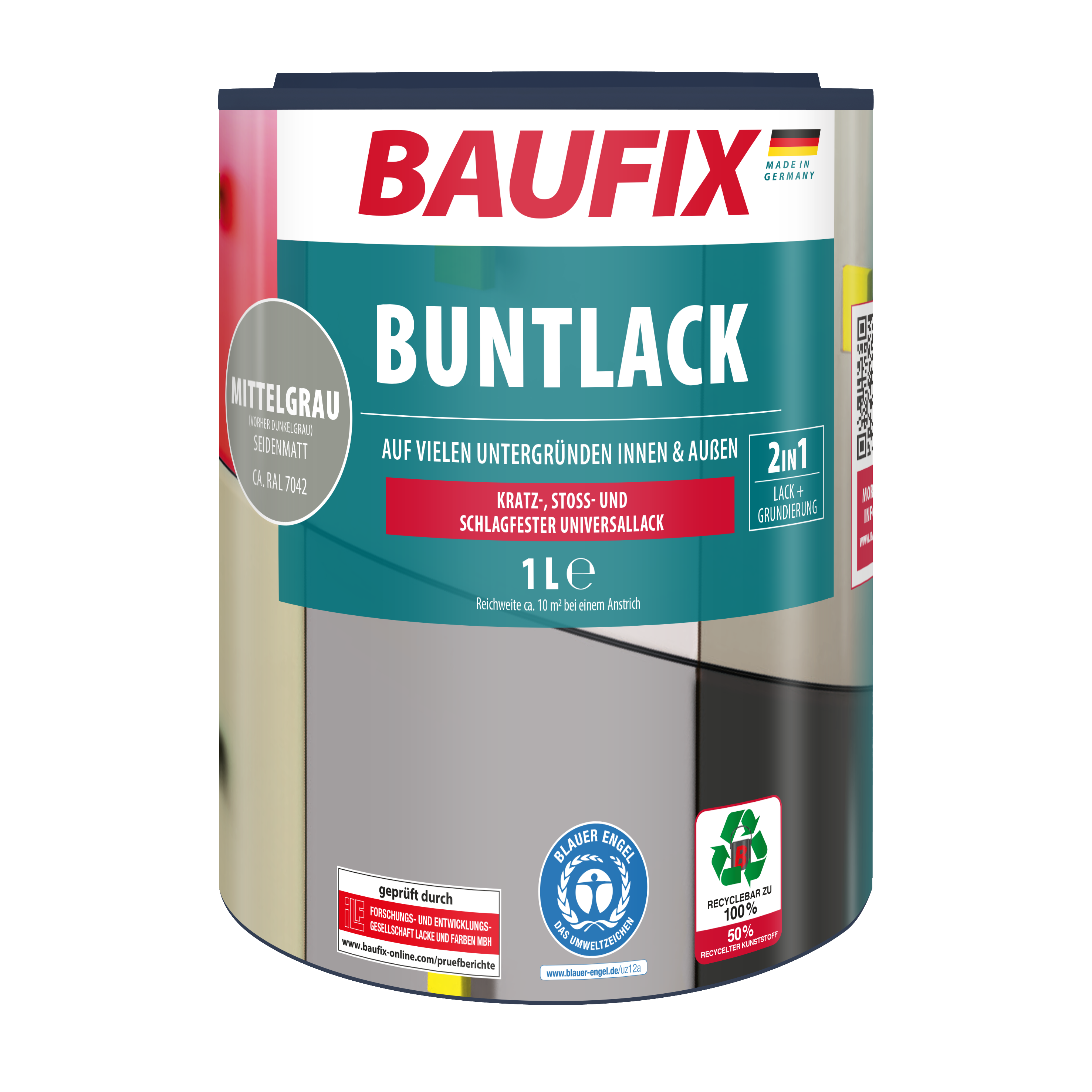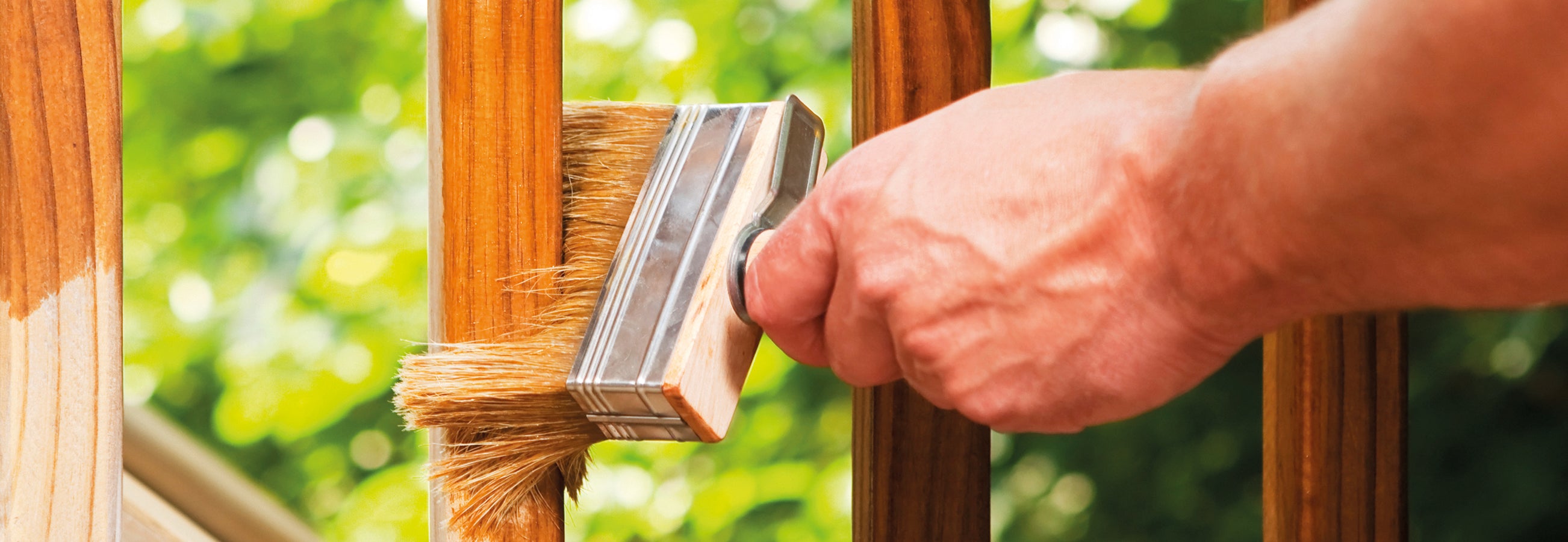
subheading
BAUFIX colored varnish, satin finish
- for indoor & outdoor
- quick-drying
- water-dilutable
- good adhesion properties
- suitable for wood, zinc, concrete, iron and masonry
subheading
Painting a wooden ceiling - step-by-step instructions & tips
A wooden ceiling gives rooms warmth, naturalness and an inviting atmosphere. Over time, however, color changes, wear and tear or a desire for a more modern look can mean that a new coat of paint is necessary. Painting a wooden ceiling is not only a way to change the appearance of a room, but also an effective way to protect the material and ensure its longevity. Whether white for a brighter ambience or a colorful accent - choosing the right paint and careful preparation are crucial for a convincing result. In this guide, you will learn how to paint a wooden ceiling, which materials and tools are needed and which steps are important for a perfect finish.
Painting a wooden ceiling: What you need for the painting work
- Covering film : To protect floors, furniture and walls. · Painter's tape or adhesive tape: For clean edges at wall and ceiling transitions.
- Cleaning cloths or sponge: For cleaning the wooden ceiling and removing sanding dust.
- Sandpaper (grain size 120-180) or orbital sander: For sanding the wood surface.
- Dust mask and safety glasses : For protection against dust and fumes.
- Brushes (flat and round brushes): For corners, edges and smaller areas.
- Paint roller (short pile or foam): For larger areas and an even result.
- Paint tray : For easy collection of paint.
- Stirring rod : For thoroughly mixing the paint.
- Primer (if necessary): For absorbent or untreated wooden ceilings. ·
- Wood paint or glaze : Depending on the desired look (opaque or transparent).
- Sealing (optional) : For additional protection and durability.
subheading
Step-by-step instructions: Painting a wooden ceiling
1. Prepare the room
Clear the room as much as possible so that you can work without being disturbed. Cover the floor with painter's fleece or masking paper, as these materials are non-slip and durable. Protect any remaining furniture with foil. If you have permanently installed lights, have them removed by a professional to ensure you can work safely.
2. Prepare the surface
Remove dust and dirt with a vacuum cleaner and clean the wooden ceiling with a mild detergent and lukewarm water. Then wipe with clean water and let the surface dry thoroughly. If the wooden ceiling has old, damaged layers of paint or bumps, remove them with sandpaper or a paint stripper. To do this, apply the stain with a paint stripper brush and allow it to take effect according to the manufacturer's instructions. You can then remove the old paint with a spatula.
Now sand the wood surface lightly so that the new paint adheres better. Fill knotholes and cracks with wood filler, let it dry and then sand the areas with
Sandpaper or a sander to make it smooth. Remove all sanding dust before painting the wooden ceiling.
Apply primer (if necessary)
If your wood ceiling is made of untreated wood, prime the ceiling panels to prevent tannins from bleeding through and causing unsightly stains. Spread the primer evenly and allow it to dry thoroughly according to the manufacturer's instructions.
4. Painting the wooden ceiling
Prepare your tools such as a brush and paint roller. Start with a flat brush to carefully paint the edges and recesses. Then use a paint roller for the larger areas. Always work in the direction of the wood grain and apply the paint wet-on-wet to avoid visible streaks. Allow the first coat to dry for about four to six hours.
subheading
5. Second coat (optional)
For an even and perfect result, you can apply a second coat once the first coat is completely dry, repeating the same steps as before. Allow the second coat to dry for 12-24 hours.
6. Sealing (optional)
If you have painted wall panels that will be subject to heavy use, apply a protective sealant after the paint has dried. This will make the surface more durable and resistant to scratches and dirt. This step is usually not necessary when painting a wooden ceiling.
7. Final theses
After painting the wooden ceiling, carefully remove all masking foil and painter's fleece before the paint has completely dried. This will prevent damage. After the paint has completely hardened (after about 14 days), you can put the furniture back and reattach the lamps. Now your room with a freshly painted wooden ceiling is ready for a new, modern look!
subheading
What color should you paint a wooden ceiling?
Choosing the right color to paint a wood ceiling depends on the look you want, the room's function, and the texture of the wood ceiling. Here are the best color options:
subheading
1. Acrylic paints (water-based)
Advantages :
- Fast drying
- Low odor and environmentally friendly
- Easy to process
Recommendation :
Perfect for living rooms and bedrooms, acrylic paints offer a smooth, matte or semi-gloss finish and are ideal for bright, modern looks.
subheading
2. Wood varnish (water- or solvent-based)
Advantages :
- High durability and abrasion resistance
- Good coverage and protection against moisture
Recommendation :
If you want a durable, smooth and resistant surface, for example in kitchens or bathrooms, painting the wooden ceiling with varnish is the best choice. Paint the ceiling in a matt or glossy finish, depending on your desired style and the effect of the room. Colored varnish protects the wood from moisture and is easy to clean, making it ideal for areas subject to heavy traffic.
subheading
3. Chalk paint (matt and breathable)
Advantages :
- Natural, matte look
- Environmentally friendly and non-toxic
- Good adhesion even without primer
Recommendation :
For rustic, Scandinavian or vintage designs, painting the wooden ceiling with chalk paint is a great option. It gives the ceiling a warm, cozy look.
subheading
4. Glaze (for natural wood look)
Advantages :
- Glazing preserves the natural wood grain
- Protects against UV rays and moisture
Recommendation :
If you want to leave the wood grain visible, paint the wooden ceiling with a glaze. This is available in transparent and colored versions for a subtle color accent.
subheading
Painting a wooden ceiling – how to do it without dripping
Painting a wooden ceiling overhead is easier if you follow the right technique and preparation. Cover the floor and your furniture with masking film, painter's fleece or paper to protect them from paint splashes. Dip the brush only about ⅔ of the bristles into the paint so that it is applied evenly and does not drip down. When working with the paint roller, make sure that the handle does not dip into the paint tray to avoid drips. First paint the edges and corners with a brush and then work your way in even strips with the paint roller. Overlap the strips slightly and roll slowly to avoid splashes. Clean your tools thoroughly after painting. This will give you a clean and professional result.
FAQ: Frequently asked questions about painting wooden ceilings
Yes, coated wood panels can be painted if they are properly prepared. Clean the surface thoroughly with a degreasing cleaner and sand it lightly with fine sandpaper to improve adhesion. Then apply a special adhesion primer for smooth surfaces. You can then paint the panels with a suitable varnish or a special panel paint. Two coats of paint are recommended for a long-lasting result.
Yes, you can paint a wooden ceiling with wall paint, but it is not ideal. Wall paint only adheres to wood to a limited extent and can flake off more quickly. For better results, we recommend that you first clean the ceiling thoroughly, sand it lightly and treat it with a primer. You can then use a hard-wearing, water-based varnish or special wood paint. This will keep the surface beautiful and durable for longer.
Yes, tongue and groove boards can be painted. Good preparation is also important here. First paint the joints with a brush and the surfaces with a paint roller.
The choice of color for a wooden ceiling depends on your desired style and the effect of the room:
- White : A classic that makes rooms appear brighter and larger. Particularly suitable for low or dark rooms.
- Natural tones : Beige, sand or grey tones radiate warmth and coziness, ideal for the living room or bedroom.
- Wood-colored glaze : Paint the wooden ceiling with a transparent glaze to preserve the natural wood look and protect the wood.
- Dark tones : Anthracite, dark blue or even black create a dramatic, modern atmosphere, but are better suited to high rooms.
Consider the size of the room, the available light and your interior design style to choose the right color for your wooden ceiling.

